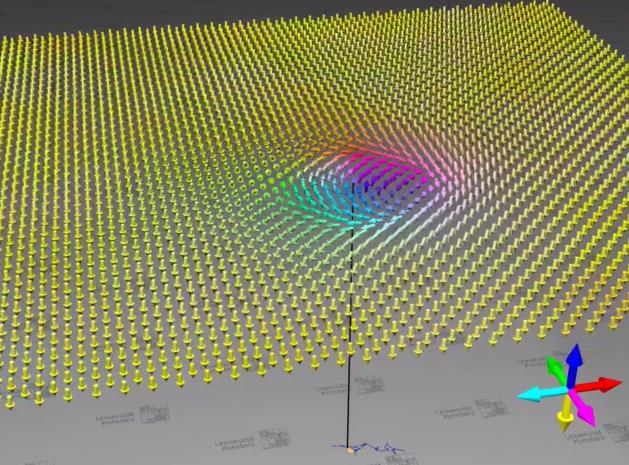
A step towards probabilistic computing
Working group led by physicist Professor Ulrich Nowak at the University of Konstanz, in collaboration with a team of physicists from Johannes Gutenberg University Mainz, demonstrates how skyrmions can be used for the computer concepts of the future
When it comes to performing a calculation destined to arrive at an exact result, humans are hopelessly inferior to the computer. In other areas, humans are still lengths ahead of it: An example is signal processing, which plays an important role in autonomous driving. In the search for new computer concepts that are closer to the human brain, research is concentrating, amongst others, on probability-based computing. Together with his team, physicist Professor Ulrich Nowak from the University of Konstanz is investigating how these computers of the future can be made possible by using what are known as skyrmions, i.e. magnetic vortex-like configurations, as bit units. In collaboration with physicists from Johannes Gutenberg University Mainz, the researchers have now been able to show both in theory and experimentally how magnetic vortices can be used for new computing methods. The results were published in the current issue of the scientific journal Nature Nanotechnology.
In waking state, humans continually perceive everything going on around them. This perception generates data streams that the brain analyses on an ongoing basis. For example, if a sound becomes louder and louder, from a certain threshold upwards it might be identified as the danger of an object flying towards you. The brain does not react to specific numerical values but instead to signals that occur with certain probabilities. As with the quantum computer, it is hoped that the future generation of computers, which uses skyrmions to process and store data streams, will offer far higher storage capacity, speed and energy efficiency. Indeed, the stable magnetic skyrmions also have the advantage that they make computing with random signals conceivable.
The working group in Mainz led by Professor Mathias Kläui has succeeded in developing a material in which skyrmions can form. The researchers have also developed a method to exploit thermal diffusion of skyrmions in what is referred to as a reshuffler, a component needed for probabilistic computing. Ulrich Nowak’s team was able to show in a simulation that the skyrmions observed indeed behaved like particles and moved around randomly in the plane, similarly to atoms that distribute themselves in gas or liquid at finite temperature.
This property is used for the reshuffler. “We have shown according to which laws diffusion occurs, its length and time scales and that it can be measured,” said Ulrich Nowak, summarizing the Konstanz researchers’ contribution to the joint project. Up until now, there have been no quantitative predictions for this. Only the combination of the measurements performed by Nowak’s colleagues in Mainz and the simulations conducted in Konstanz has shown the relevance of skyrmion diffusion. Since skyrmions can be produced and rearranged by means of electric currents, they are suitable candidates for a reshuffler.
What is understood by a reshuffler is a component of probability-based computing that automatically scrambles input data like a kind of mixer. The reshuffler produces a sequence with the same number of memory units but in a different order. Their probability has therefore remained the same.
Key facts:
- Original publication: Jakub Zázvorka, Florian Jakobs, Daniel Heinze, Niklas Keil, Sascha Kromin, Samridh Jaiswal, Kai Litzius, Gerhard Jakob, Peter Virnau, Daniele Pinna, Karin Everschor-Sitte, Levente Rózsa, Andreas Donges, Ulrich Nowak & Mathias Kläui: Thermal skyrmion diffusion used in a reshuffler device. Nature Nanotechnology, 22 April 2019. DOI: https://doi.org/10.1038/s41565-019-0436-8
- Collaboration between the working groups led by Professor Ulrich Nowak at the University of Konstanz and his colleague Professor Mathias Kläui from Johannes Gutenberg University Mainz. Mathias Kläui worked at the University of Konstanz from 2003 to 2008, earning his habilitation (postdoctoral qualification) at the University of Konstanz in 2008.
- Combination of measurements from Mainz with simulations from Konstanz show the relevance of skrymion diffusion.
- The research work by the University of Konstanz was funded in the framework of the “Skyrmionics” Priority Programme of the German Research Foundation and Collaborative Research Centre (CRC) 767 of the University of Konstanz.

